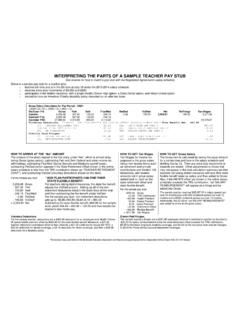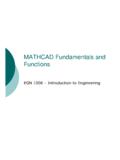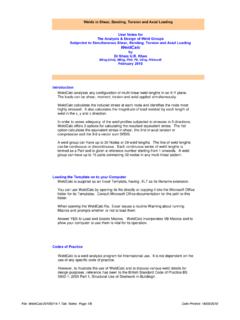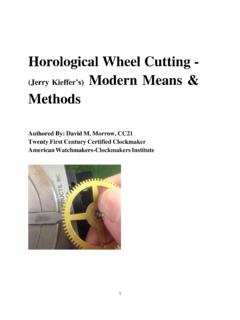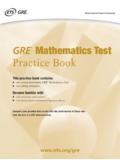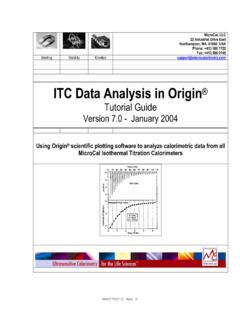Transcription of Unit 1: Motion - SAMPLE - bps-ok.org
1 INQUIRY PHYSICSA Modified Learning Cycle Curriculumby Granger MeadorSAMPLE of unit 1: MotionThis online SAMPLE includes the Teacher s Guide,Student Papers, and SAMPLE Notes for unit 1 of to order your copy of theentire curriculum today, complete with: 20 units 213 pages of teaching suggestions, includinganswers to the student assignments 124 student assignments across 290 pages, including26 labs (PDF format and also as both Word and WordPerfect files you can edit to your liking) 175 pages of SAMPLE notes covering each unit (all in PDF format as well as editable Word files you can customize to your liking) 9 high-quality presentations (all in PDF format as well as editable PowerPoints you can customize to your liking) 600 megabyte compressed file archiveVersion 2014 by Granger MeadorINQUIRY Modified Learning Cycle Curriculumby Granger Meador, 2010 unit 1: MotionTeacher s Guidethese TEACHER S GUIDES are copyrighted and all rights are reservedso you may NOT distribute them or modified versions of them to othersHowever, the STUDENT PAPERS, SAMPLE NOTES, and any PRESENTATIONS for each unithave a creative commons attribution non-commercial share-alike license; you mayfreely duplicate, modify, and distribute them for non-commercial purposes if you giveattribution to Granger Meador and reference MotionTeacher's GuideInquiry PhysicsKey ConceptsSpeed is the measurable rate of change in the position of an object.
2 Acceleration is the measureable rateof change in speed. Both graphical and numerical representations of position, speed, and accelerationcan be utilized to describe and predict PapersLab: Galilean Ramp (analyze Motion of ball/cart down a track)Worksheet A: Calculating Motion (initial Motion problems and a graph)Worksheet B: Interpreting Motion GraphsWorksheet C: Combining the Variables of Motion (formulating additional equations)Worksheet D: 1-Dimensional Motion ProblemsWorksheet E: Quiz ReviewIntroductionStudents are aware that such ideas as speed, velocity, and acceleration exist, but they are often unawareof how to distinguish one of those ideas from another. Since the students are not proficient with theconcept of vectors, this investigation only uses speed. Do NOT feel compelled to introduce the velocityconcept here; that will come later in unit two. Tell the students that the symbol v will be used for speed toavoid confusion later key equations arise from this investigation:Average speed is the change of distance with respect to time, or Acceleration is the change of speed with respect to time, or If acceleration is constant, average speed is also given by INQUIRY PHYSICS TEACHER'S GUIDE FOR unit 1: MOTIONPAGE 2 OF 18 unit 1: Motion Lab: Galilean Ramp, pages 1-3 Pre-LabPreface this lab with definitions, examples, and discussion of accuracy, precision (or tolerance, dependingon your text or personal usage), and parallax.
3 Also instruct them on the proper use of significant figures,and refresh them on the basic metric system (SI) prefixes. Also refresh your students on the basicequations and graphical forms of linear, parabolic, and hyperbolic functions. This will help them interprettheir graphed data and develop the concepts regarding d vs. t, v vs. t, and a vs. t for each group (of 3 to 4 students):grooved wooden track OR air track OR other dynamics track with ball or cart, about to 2 m longif using a wooden track, a 7 mm groove should run lengthwise along the track for a steel ball( large ball bearing) to roll along; a wooden block or other stop will be needed at the bottom ofthe trackring stand OR blocks to incline the trackball for wooden track (diameter $ 2 cm and mass $ 60 g) OR air track glider OR wheeled toy/cartmeter stick - show the students how to read the meter stick to as many decimal places(precision/tolerance) as possible; typically they'll be reading 3 to 4 significant figuresstopwatchmasking tape (unless track is ruled)PART ONE:Only pass out the first two pages of the lab to begin with; the third page is designed to be pre-loaded into aprinter for printing of a distance vs.
4 Time graph (or students can put a hand-plotted graph in that space). The fourth page is similarly designed for a speed vs. time graph, and will not be used until a day or twoafter the lab begins. Don t worry if your students can t use computers or calculators - later in this guideyou ll be shown how to handle a parabolic relationship without such the data collection, each group should set up the equipment in exactly the same way so that the classdata can be compiled, compared, and used to invent the concepts. Each student in a group should havean assigned role ( ball/cart release, timing, recorder, and ball/cart stop and return). For this first lab,stress that students should check each other on their the students collect data, discuss with them the various experimental errors to be avoided orminimized, such as: which part of the ball or cart is to be held at the mark on the tape (the front, not themiddle or back), how should the release and timing be coordinated (verbal cue from timer), how theball/cart should be released (by swiping a pencil held in front of it straight down the track away from theball/cart, not pulling it upward or sideways to avoid backroll and spin), and why the longest run ismeasured first (because it is the one least affected by timing errors; the shorter runs where timing errorsare more significant are saved for the end when the experimenters are more practiced).
5 PART TWO:The labs are written so students could, if desired, use the Graphical Analysis program from VernierSoftware ( ) to input and graph their data. Space has been left blank on lab pages 3 and4 so that they can be pre-loaded into a printer. Another option is for students to analyze the Motion usingMicrosoft Excel or another spreadsheet, or to graph the data by hand. I do NOT advocate usingprobeware to analyze the Motion , as this can easily short-circuit the development of the concepts. Delayusing probeware until after unit two, when the vector concepts are in place; one can then have studentspredict and analyze Motion graphs collected as they move in front of a Motion using a calculator or computer to graph, first show the students how to use the machinery. Have themmake their graphs, get them approved, print them, and answer the questions on lab pages 2 and 3. In theapproval process, check that they have plotted (0,0); if they haven't, engage them in a discussion toillustrate its PHYSICS TEACHER'S GUIDE FOR unit 1: MOTIONPAGE 3 OF 18 unit 1: Motion Lab: Galilean Ramp, pages 1-3 What if my students do not have access to a computer or calculator for graphing?
6 Many of the graphs in this curriculum are linear, so students can simply plot the points by hand andeyeball a best-fit line. Careful plotting and drawing of the best-fit line will yield equations with useful slopevalues. However, in this first lab they face a squared relationship, and hand-drawn parabolas are your students need to construct graphs by hand (or if the graphing software cannot handle quadraticfits), that need not prevent them from decisively determining the numerical relationship between distanceand time. They ll just need to draw two different graphs - one to determine the type of relationship and thesecond to find the numerical values in it. You will probably need to lead them through the process withsample data or a class the data and note the shape of the best-fit curve and its general have the students graph distance vs. time (time always goes on the x-axis, even when it isthe dependent variable). Have them eyeball a best-fit curve to the data points, which should yielda reasonable half-parabola.
7 You will then need to ask them to identify the mathematical meaningof that shape, or lead them to realize that it implies that distance is directly proportional to thesquare of for the discovered relationship and re-plot next step is to test for that squared relationship. The students will now compute the square ofthe time for each part of the experiment. Then have them graph distance on the y-axis and timesquared on the x-axis. If their data is good, the points should plot out in a roughly straightdiagonal squared relationship will yield a straight line on the second the students what the line means. It means that distance is directly proportional to the squareof time. Have them eyeball a best-fit line for the second graph. (Here it is useful to remind themthat a best-fit line need not hit even a single plotted data point nor go through the origin. A best-fitline runs through the middle of the data point distribution.)
8 The slope of the best-fit line to obtain the the students have drawn the best-fit straight line, have them compute its slope. Theresulting equation will be d = k t + b where d is the distance, k is the slope, t is the square of the22time, and b is the graph s y-intercept. Voila! They now have about the same equation a fancycomputer or calculator would have calculated when forming a best-fit parabola to the originaldistance vs. time graph (the only difference is that the t term in the quadratic automatically has acoefficient of zero: d = k t + 0 t + b). the the students can fill in the equation for the graph and move on. If you have them make anypredictions about distance or time, have them use the second graph (the linear one of d vs. t)2since the best-fit line will likely be more true to the data than the best-fit NOT assume students will easily follow all of this! A common error is thinking that the second graphindicates distance and time (instead of time squared) are directly proportional.
9 Some students will simplygo through the drill of making the graphs without thinking about what they are doing, unless you questionthem verbally or in written answers for those two pages are shown PHYSICS TEACHER'S GUIDE FOR unit 1: MOTIONPAGE 4 OF 18 Distance (cm)Time (s)Average Time (s) THESTUDENTSLEAVE THISCOLUMN BLANKUNTIL LATER,WHEN THEYWILLCALCULATE THESPEED ANDRECORD Idea answer all questions in complete the independent and dependent variables in this distance is the independent variable, and the time is the a graph of distance traveled along the incline versus average time. Graphs involving time always plot time horizontally on thex-axis and the other variable vertically on the y-axis. This can violate the usual practice of placing the independent variable on the x-axisand the dependent on the need to decide if (0,0) is a valid point to include. Make sure each member of the group has a is the shape of the line on your graph?
10 (Is it straight or is it curved? If it is curved, state whether it looks parabolic orhyperbolic, etc.)It is curved, like a shape of a graph illustrates the mathematical relationship between the independent and dependent variables. What doesyour graph specifically show you about the relationship between distance and time?The distance is directly proportional to the square of the the relationship you described in question 3 as a proportionality: d % to the graph, what was the ball/cart doing as it went down the track?It was speeding up/accelerating/moving 1: Motion Lab: Galilean Ramp, pages 1-3 INQUIRY PHYSICS TEACHER'S GUIDE FOR unit 1: MOTIONPAGE 5 OF graph has a best-fit curve. What type of fit did you perform, or instruct the computer or calculator to perform (linear,quadratic, inverse, etc.)?We used a quadratic question 4, you expressed the basic proportionality between the independent and dependent variables. Your best-fit curveallows you to now express the precise equation for your group's data.
